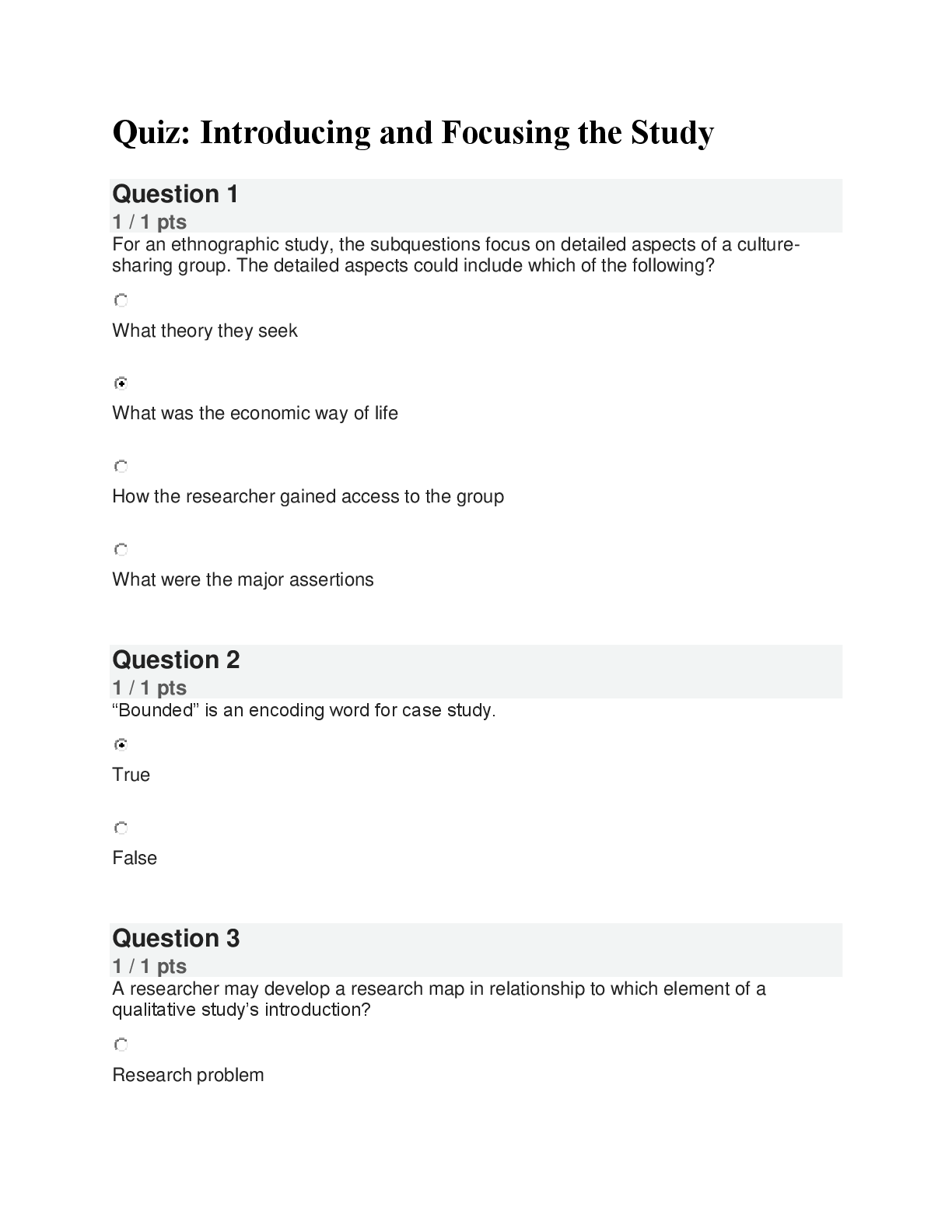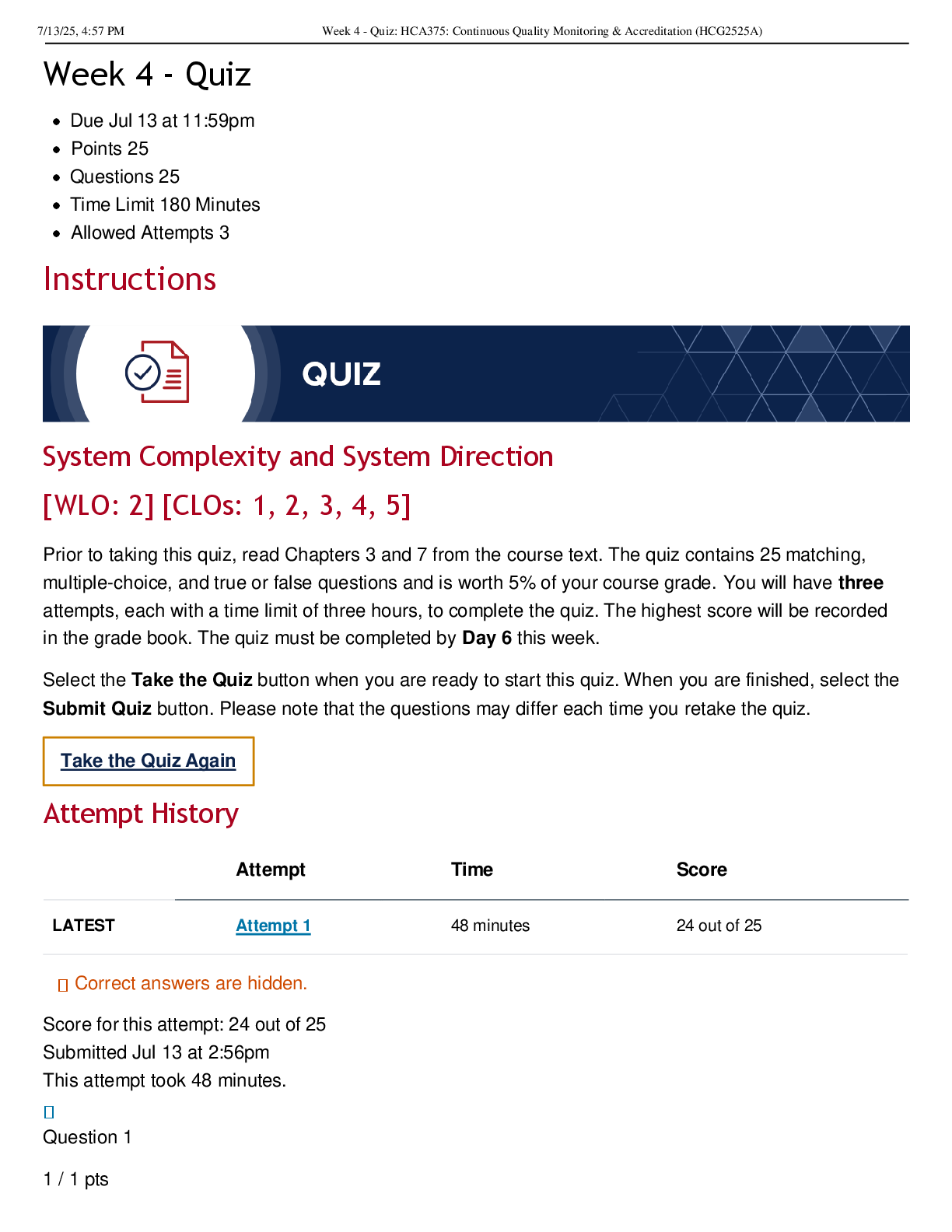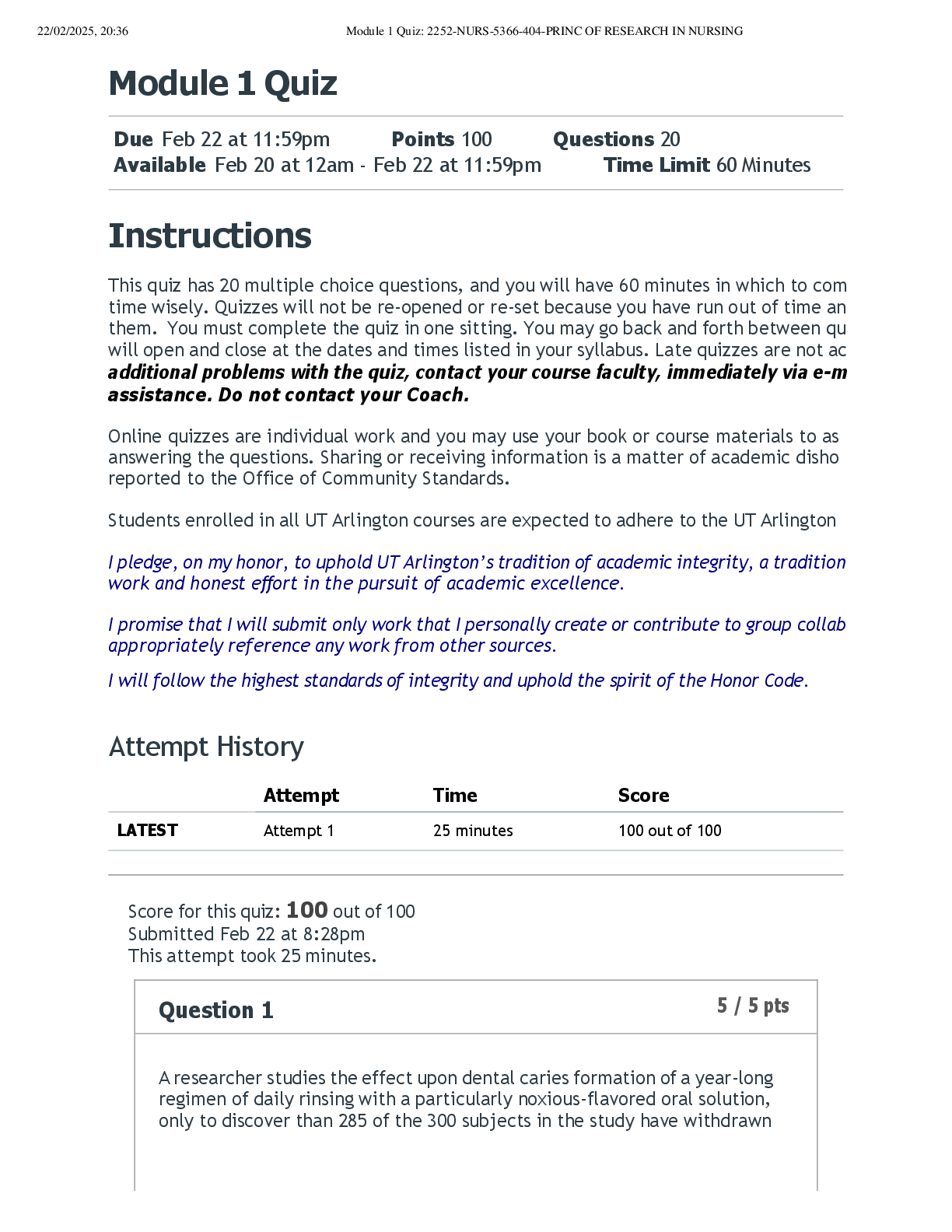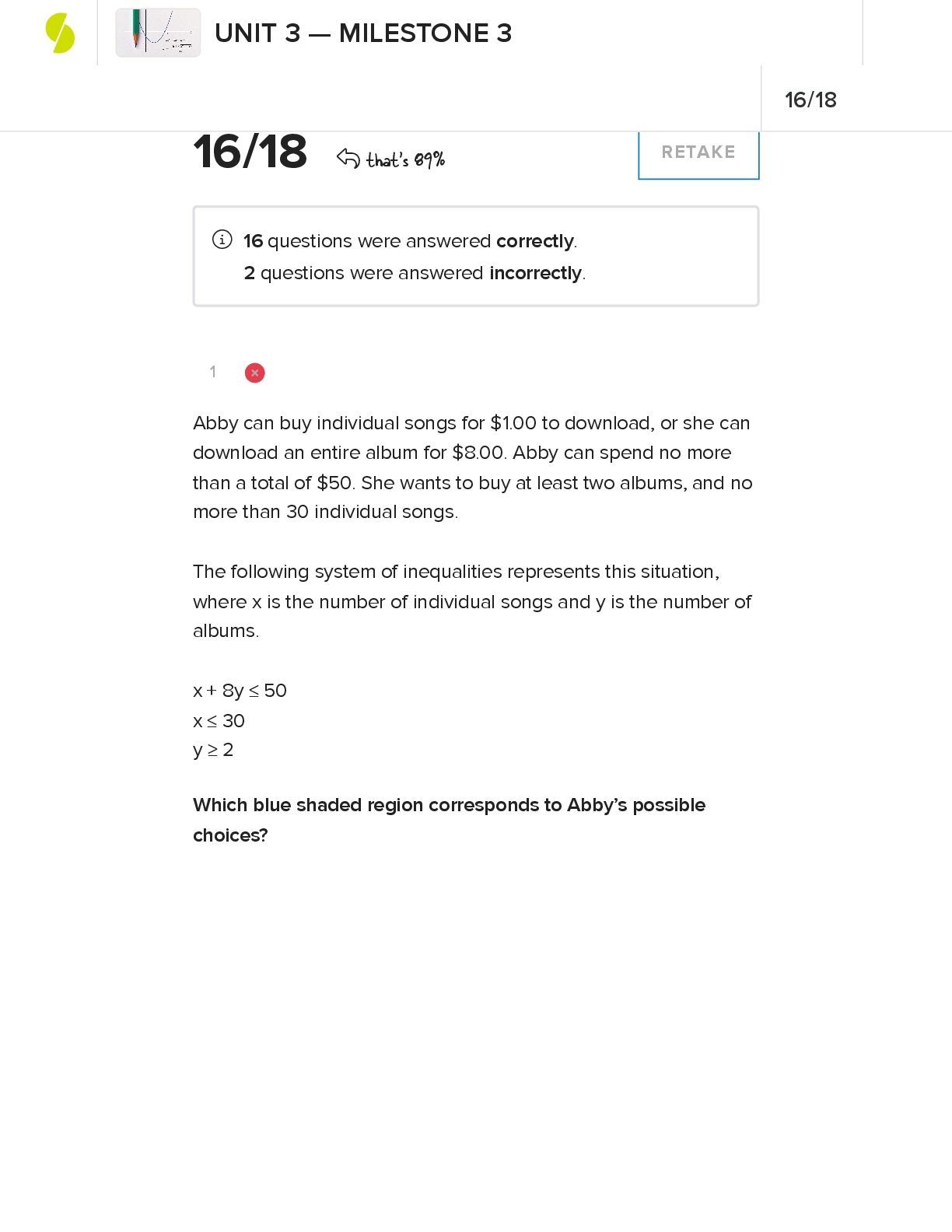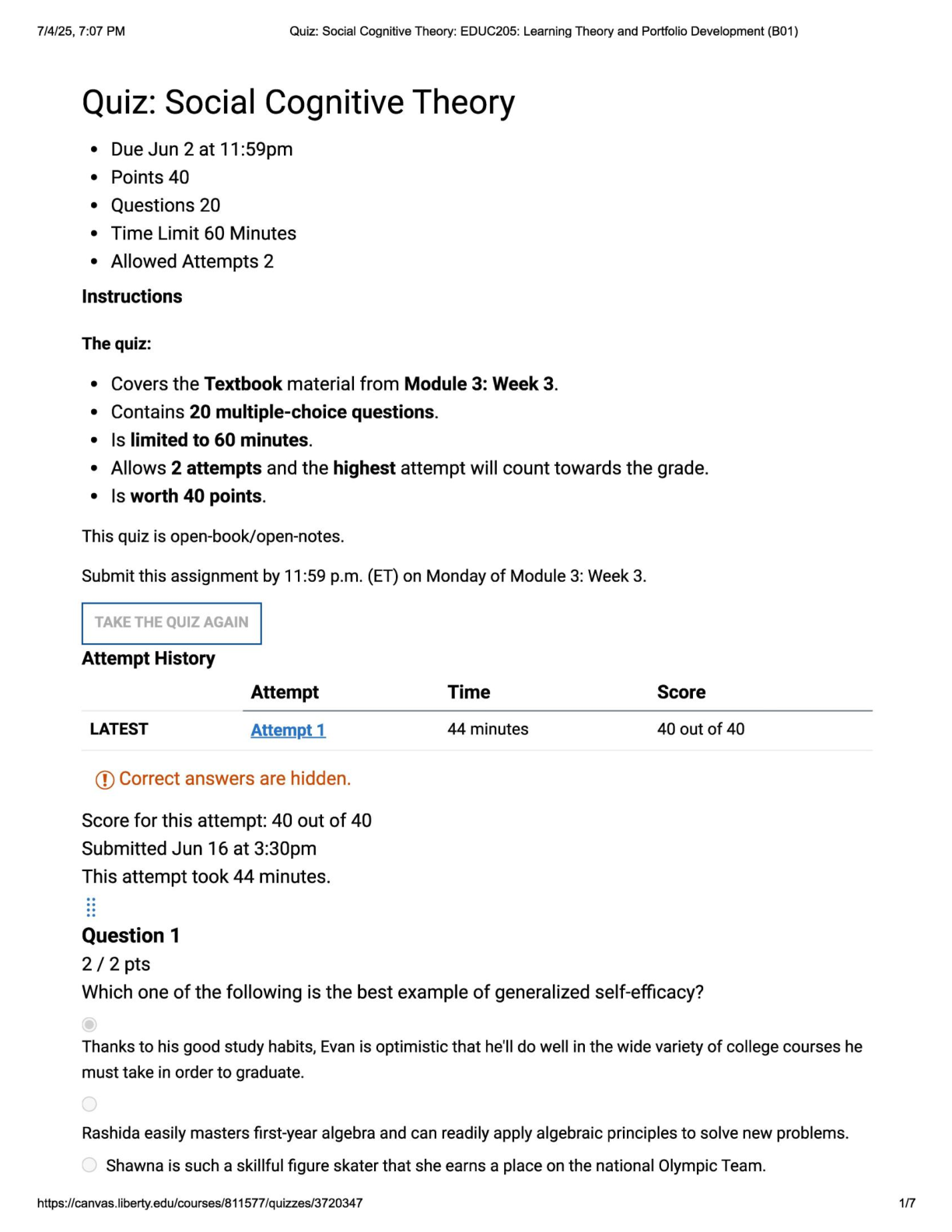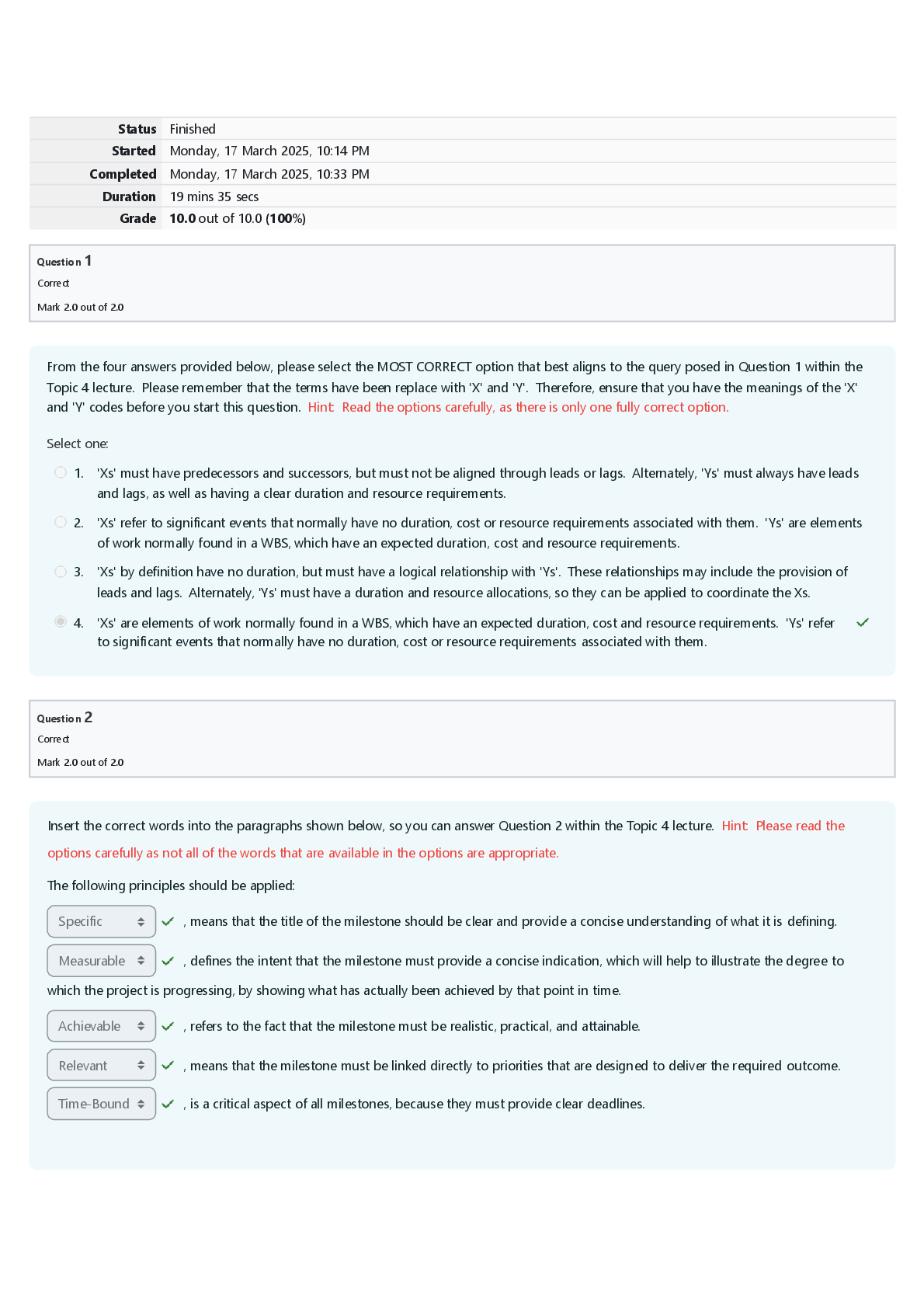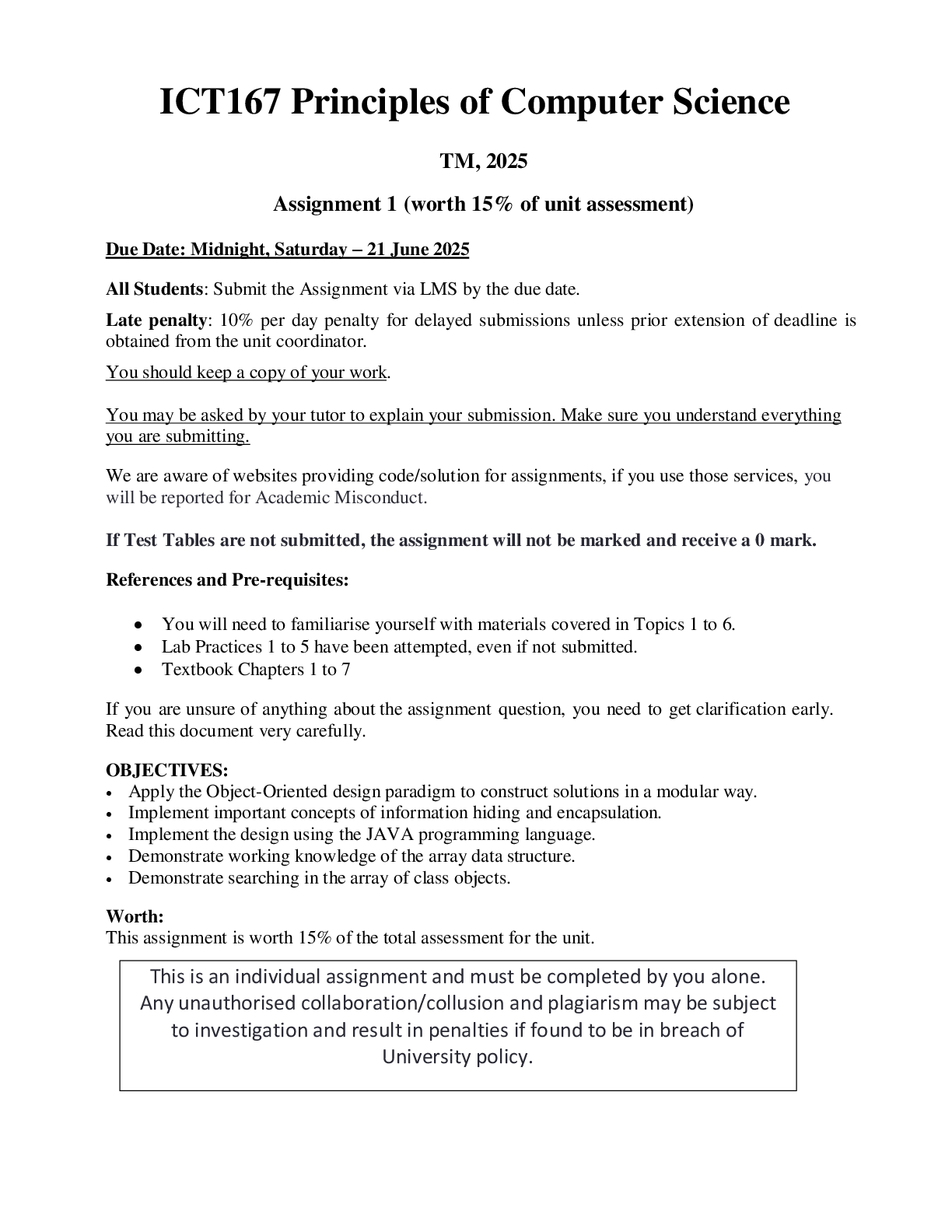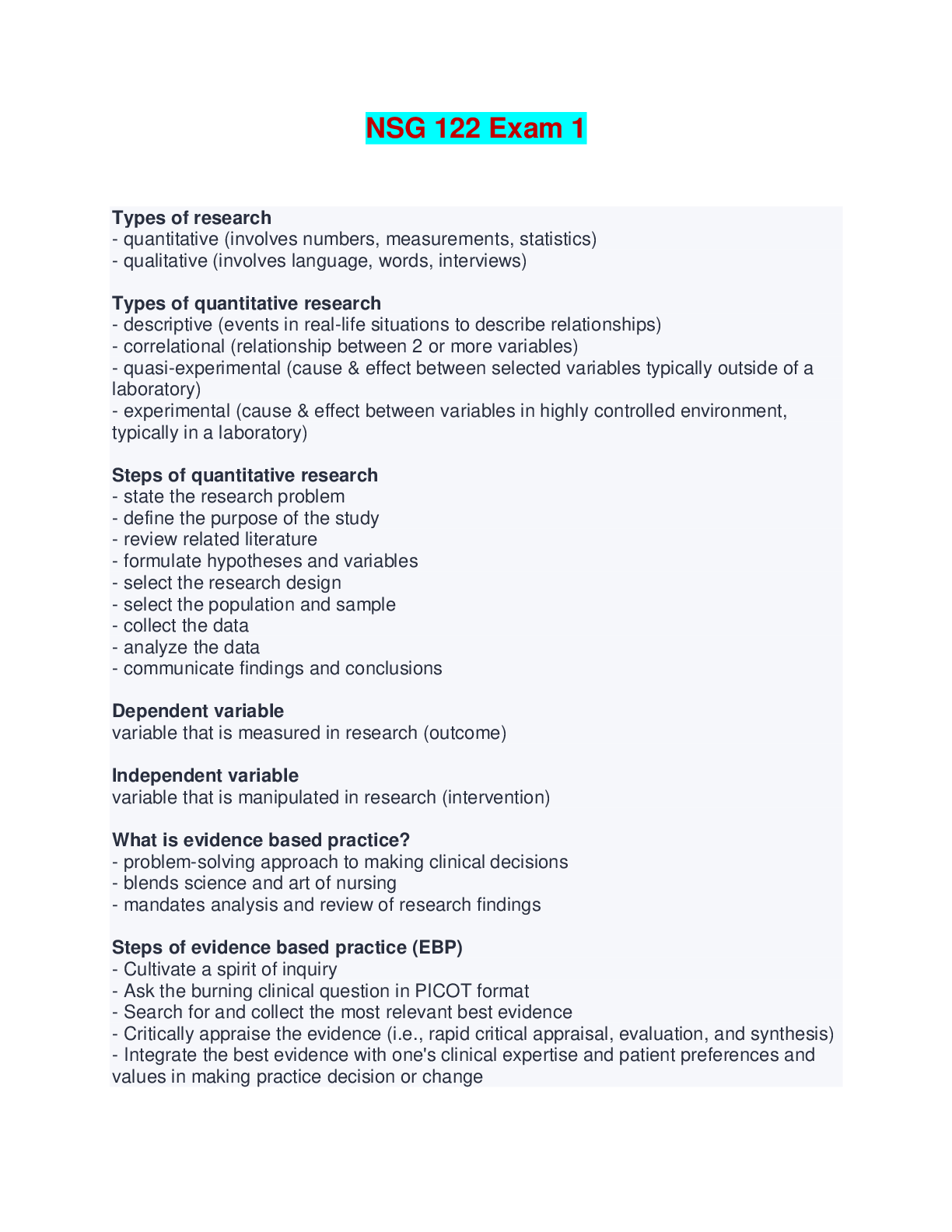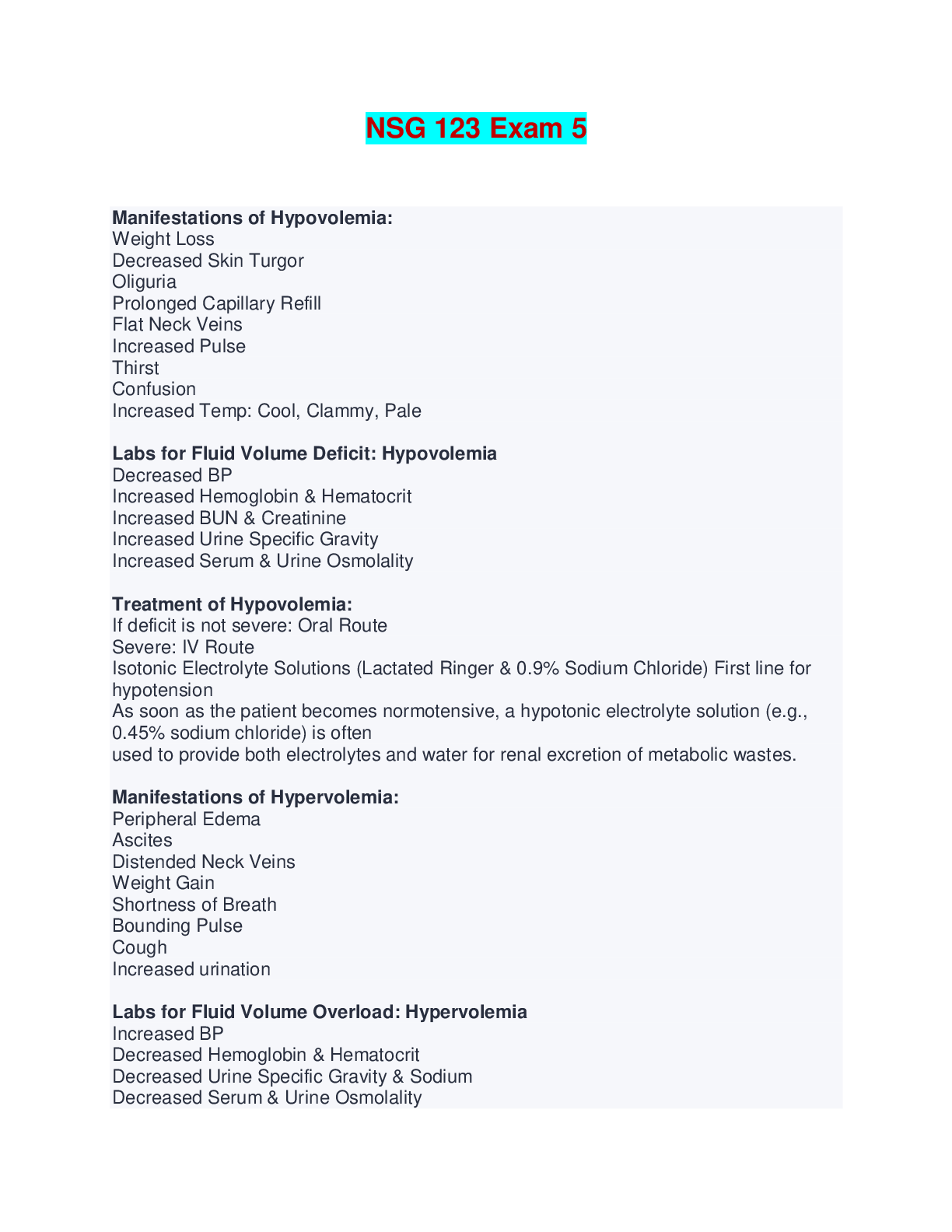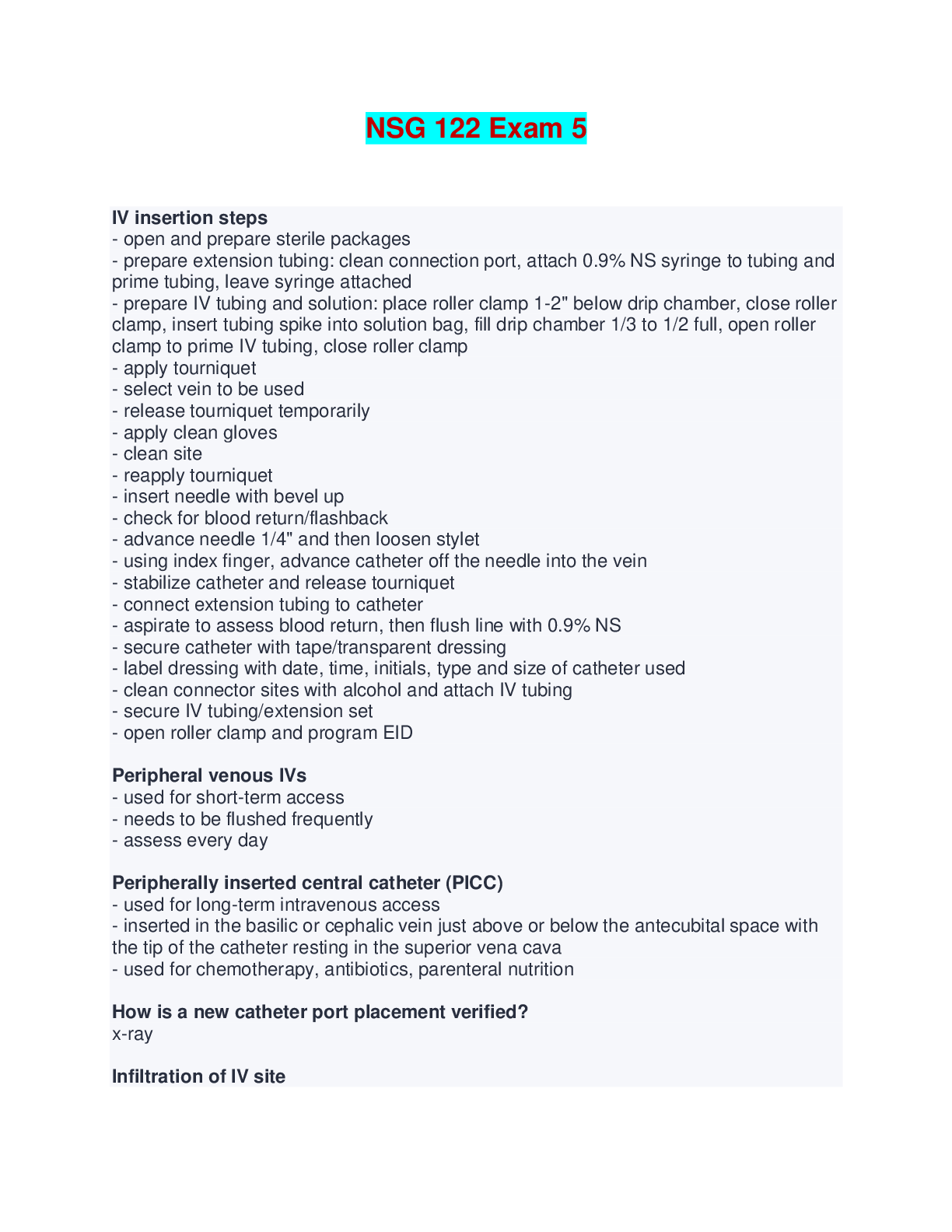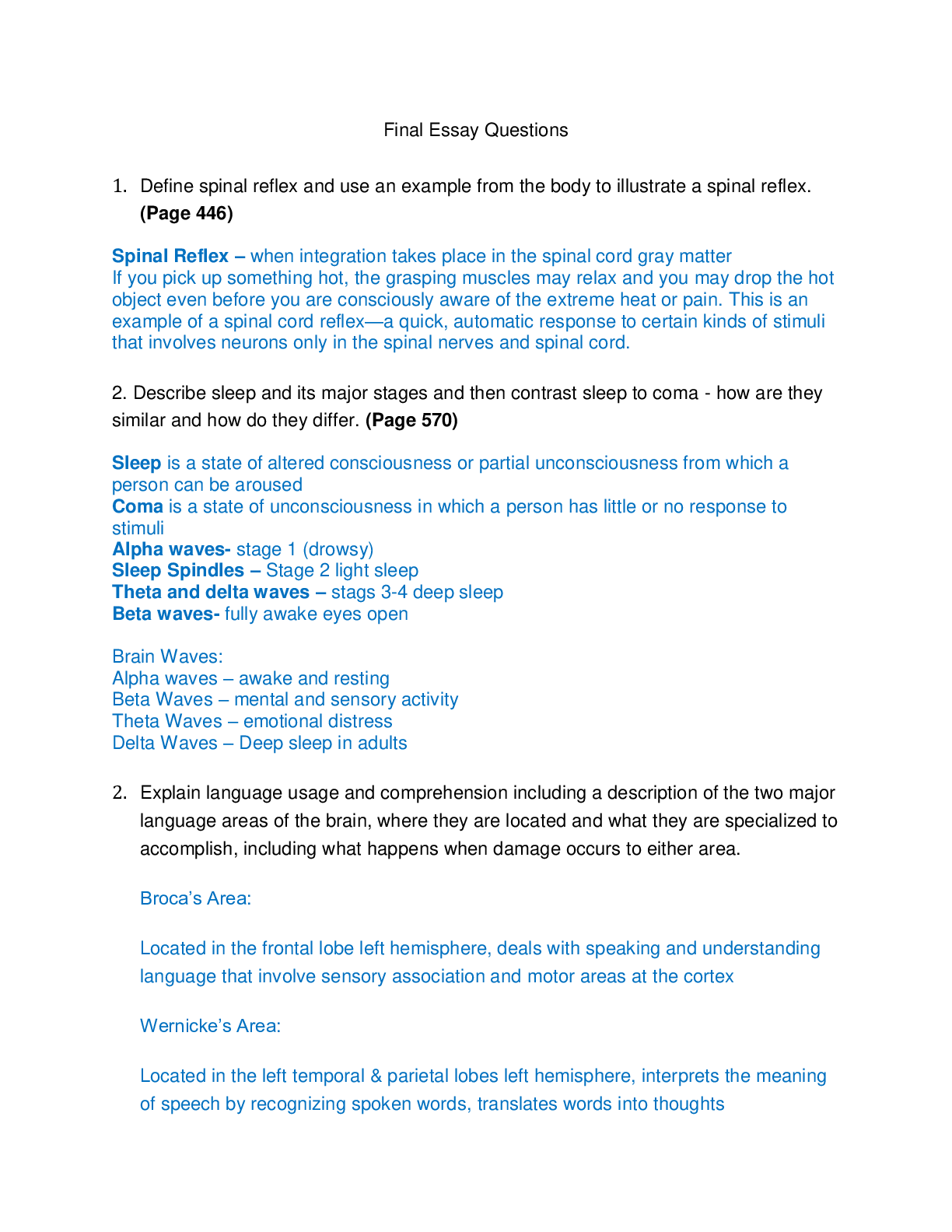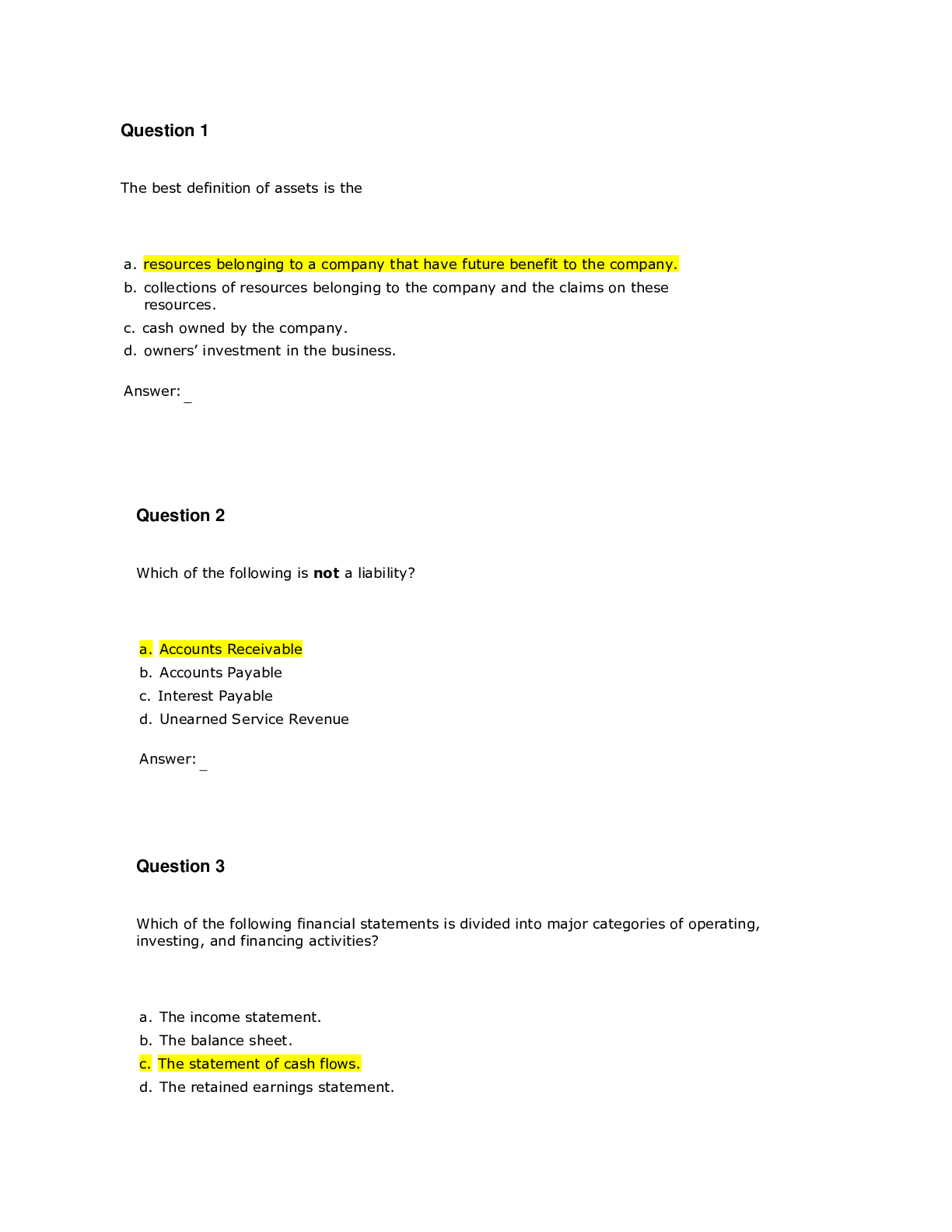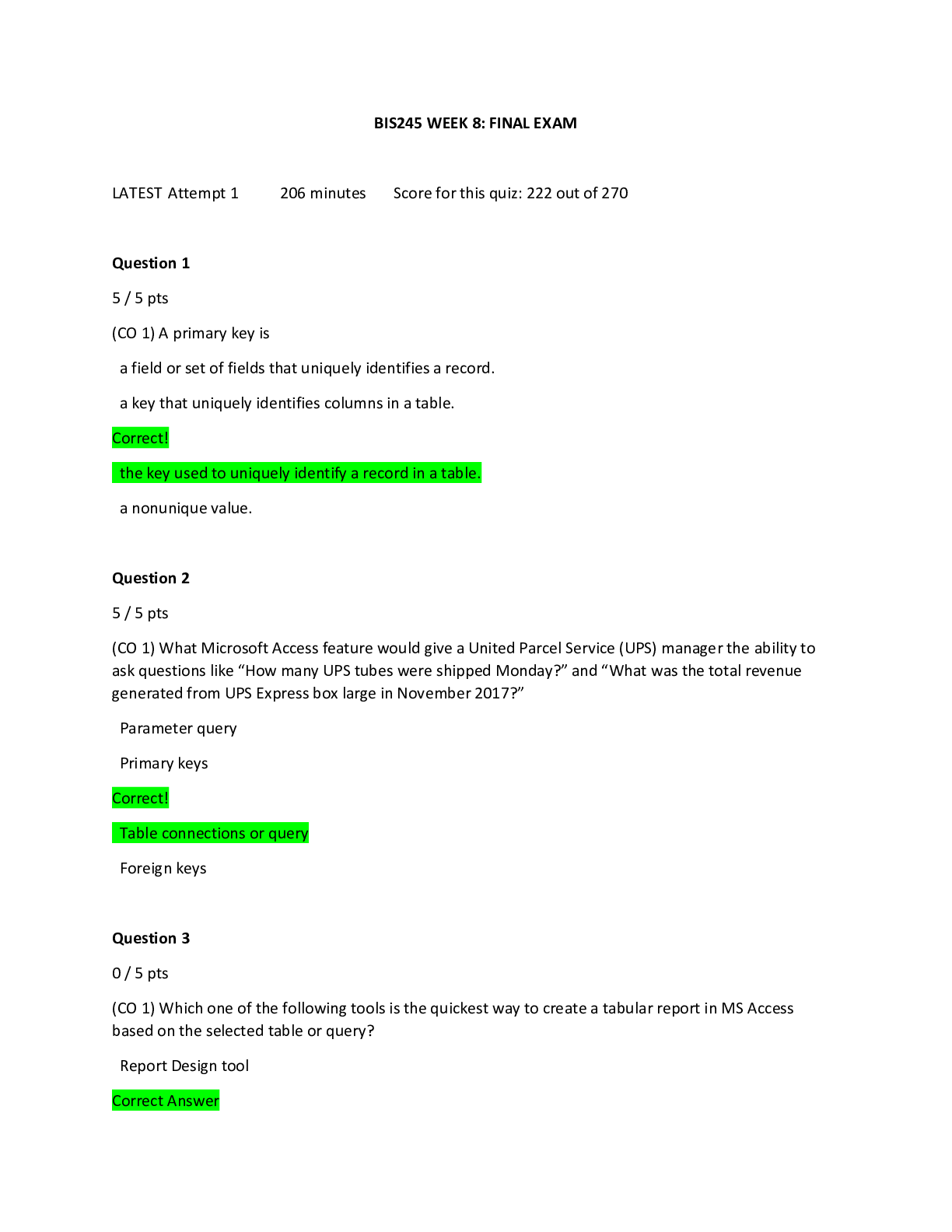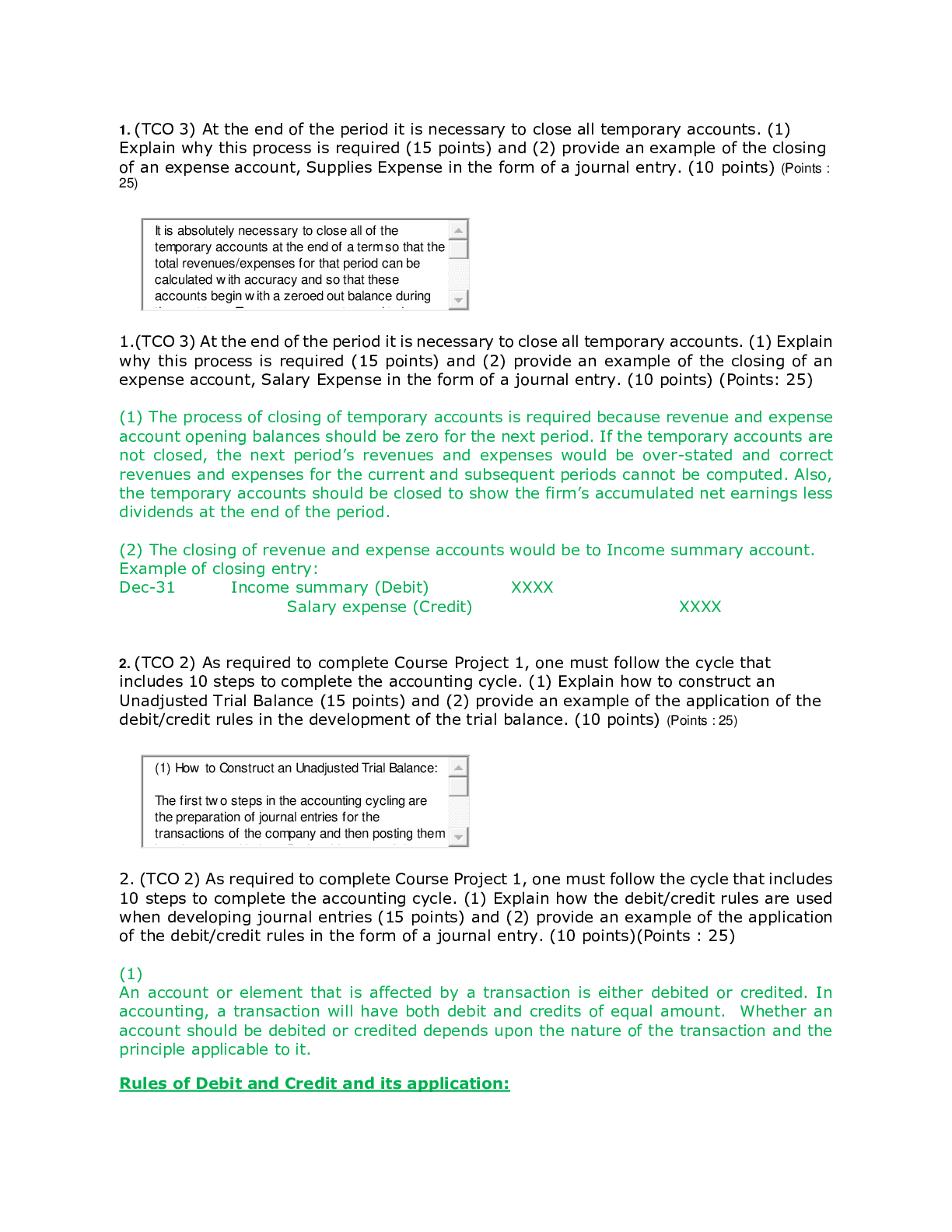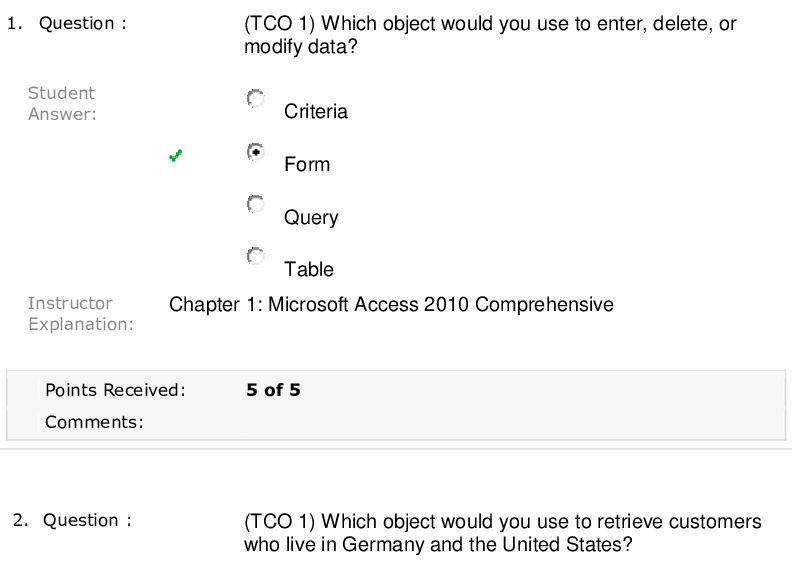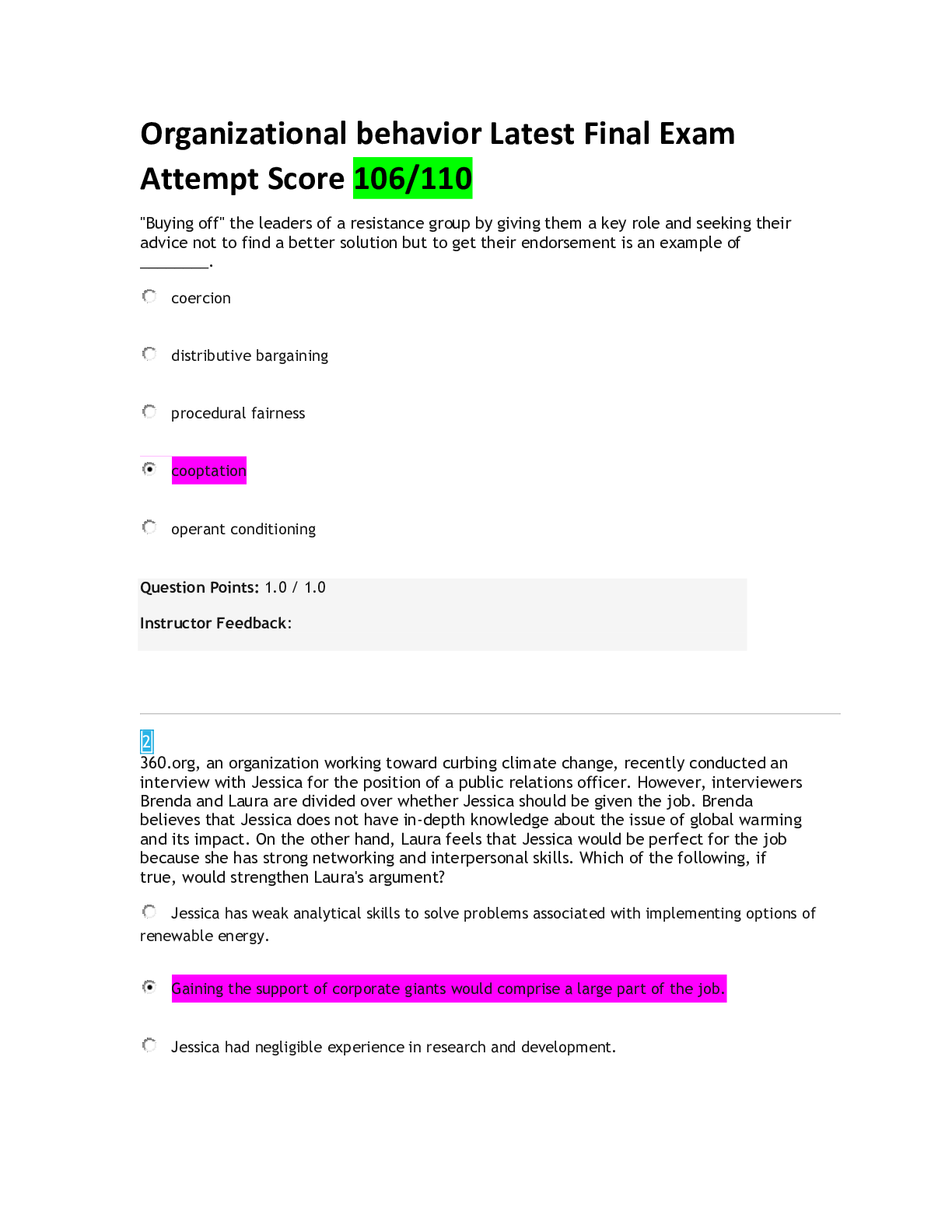Psychology > EXAM > PSYCH 232 Final Exam | Complete Solutions (Answered) (All)
PSYCH 232 Final Exam | Complete Solutions (Answered)
Document Content and Description Below
PSYCH 232 Final Exam | Complete Solutions (Answered) Obtaining a complete understanding of human personality requires that A. we focus on one or two specific approaches as a maximum. B. we examine e... very aspect of personality from a biological perspective. C. we focus our attention on the cognitive approach. D. we examine personality from several different perspectives. Obtaining a complete understanding of aggressive behavior requires that A. we focus on the unconscious motives behind our aggressions. B. we examine aggression from a variety of theoretical perspectives. C. we only examine the evolutionary basis of aggression. D. we focus our attention on the cognitions involved in aggressive choices. The way people process information in threatening situations begins with a social encounter and then depends on A. the way other people are acting in the situation. B. the way the situation is appraised in awareness. C. the kind of situation people are in. D. whether or not people are self-actualized. Among the personal factors cognitive psychologists consider when predicting aggressive behavior, which of the following is typically included? A. The provocative situation B. Genetic predisposition to aggression C. The ego defense mechanisms the person uses D. Visual cues in the environment. Which of the following is true about aggressive scripts? A. They represent ways to act that have been learned. B. We learn them by watching aggressive models. C. When they have been practiced, they are more likely to be shown. D. all of the above In a study in which researcher presented a series of hypothetical situations to boys, those with a history of reactive aggression A. were more likely to perceive actions as intentional or hostile. B. suppressed their tendency toward aggression. C. learned how to cope with the feelings of hostility. D. hardly ever had aggressive thoughts related to the situations. In a study of boys in aggression-provoking situations, such as another student breaking the boy's radio while he is out of town, researchers found that boys with a history of reactive aggression A. were more likely to interpret the act as intentional. B. were more likely to interpret the act as hostile. C. tended to act more aggressively in response to the act. D. all of the above Researchers have found that prevention programs designed to reduce reactive aggression A. have generally failed until recently. B. effectively use cognitive (behavior) therapy. C. are successful in reducing antisocial acts like assault. D. only work for very young boys. Research on recall for events between men and women has shown that men have better recall of __________ than women. A. personal events B. sporting events C. impersonal events D. emotional events Which of the following is false about emotional memories? A. The links between emotional memories are stronger for men than women. B. Both happy and sad memories are more accessible for women than men. C. Women attend to and process information about emotions more than men. D. Recalling one sad experience is more likely to trigger another sad memory for women All of the following statements about emotional memories are true except one. Which one is false? A. Women attend to emotional information more than men. B. Recalling one sad experience is more likely to trigger another sad memory for women than for men. C. Both happy and sad memories are more accessible for women than men. D. The connections between emotional memories are stronger for men than women. Research comparing the memories of men and women tend to find that A. men recall more information than women. B. women recall more information than men. C. women recall more information about emotions, whereas men recall more nonemotional information. D. men recall more information about their relationships, whereas women recall more information about emotions. Studies find that women tend to recall more information about ____________ than do men. emotional experiences Which of the following do women tend to remember better than men? A. Information about relationships B. Important dates C. Names D. Facts about American history Research findings suggest men are more likely than women to form independent self-construals. This means that men tend to A. think of themselves as independent. B. develop their self-concepts with little help from others. C. have cognitive representations of themselves that are relatively unrelated to the cognitive representations they have of other people. D. have cognitive representations of themselves that are resistant to change. Women and men differ in the kinds of information they recall. Researchers explain this in terms of differences in the way men and women A. make an effort to remember. B. form cognitive representations of themselves. C. have been trained to remember information in school. D. mature intellectually. When researchers ask men and women to write descriptions of themselves, women are more likely than men to include statements about A. where they live. B. their roles as parents and family members. C. their physical appearance. D. their age. According to negative schema theory, compared to nondepressed people, depressed individuals are more likely to A. generate thoughts that cause them to become depressed. B. change their ideas about who they are and what they want from life. C. have a high self-image that is consistently contradicted by objective facts. D. have experienced trauma in childhood. Researchers find that depressed people recall depression-related words better than nondepressed people. This finding is used to support which concept? A. Learned helplessness B. Depressive schema C. Explanatory style D. Locus of control Researchers asked participants in one study to take photographs to indicate how the participants thought of themselves. The women in the study were more likely than the men to take pictures of themselves that included other people. The findings support the notion that, compared to men, women A. are more dependent on other people. B. have a larger network of friends. C. are more mature socially. D. are more likely to develop an interdependent self-construal. According to the cognitive approach to depression, processing information through the negative schema causes people to A. become depressed. B. generate even more depressing thoughts. C. ignore positive information. D. all of the above Depressed and nondepressed participants in one study were given a list of words to recall. The researchers found A. the nondepressed participants recalled more words. B. the depressed participants recalled more words. C. the depressed participants recalled more depression-related words, but the nondepressed participants recalled more of the other words. D. differences between the two groups of participants only when the depressed participants knew what the researchers were looking for. Depressed patients in one study were asked to recall personal experiences associated with words from a list. The researchers found patients were more likely to recall unhappy experiences when feeling particularly depressed. This finding supports which concept? A. Learned helplessness B. Negative schema C. Explanatory style D. Locus of control Which of the following is a component of the depressive cognitive triad? A. Interpreting ongoing experiences in a negative light. B. Pessimistic thoughts about the future. C. Negative thoughts about oneself. D. all of the above According to cognitive researchers, the happiest people are those who A. pay attention to negative information so they can deal with it more effectively. B. pay attention to both positive and negative information equally. C. interpret ambiguous information in a positive light. D. are always on the alert for negative information. You read about cognitive research that investigated word memory in depressed people between depression-associated words and nondepression-associated words. Which of the following was not a group that recalled depression-associated words better than normal people? A. Clinically depressed patients B. Mildly depressed college students C. Nondepressed patients D. Students simply asked to think about some sad events Researchers use the idea of negative cognitive style to A. identify people at high risk for depression. B. predict students who will have at least one episode of major depression. C. determine those suffering more depressive symptoms after trauma. D. all of the above The cognitive approach to personality suggests that negative thoughts can A. be a symptom of depression. B. cause depression. C. be the result of changes in brain receptors. D. be more slowly processed. When investigators looked at the psychological effects of physical and emotion abuse of women, those suffering from deeper depression showed signs of A. a negative cognitive style. B. curiosity. C. positive emotions beginning to surface after two weeks. D. false interpretations of events since the trauma. Which of the following have researchers found about negative cognitive style? A. It is related to depression. B. Processing filters out positive information. C. It tends to identify one's problems with specific events. D. It is a form of negative reinforcement The cognitive approach to personality explains differences in personality as differences in the way people A. respond to reinforcement. B. process information. C. think about their past. D. dream. Which of the following would most likely be of interest to a theorist from the cognitive approach? A. The impact of delaying reinforcement on responding B. The number of words recalled from memory C. The effect of self-concept on daily mood D. The best techniques for uncovering unconscious thoughts Which of the following was advocated by George Kelly? A. People are largely controlled by the environmental stimuli they encounter. B. People are motivated to make sense out of all the stimuli that impinge on them. C. People are happier when they accept that life is full of unexpected turns and surprises. D. Most of what determines our behavior is not readily accessible to consciousness Kelly presented a "man-as-scientist" conception of human personality, meaning that A. no scientist can understand a person better than that person understands himself or herself. B. the human personality can be examined through scientific methods. C. people constantly try to predict and control the events in their lives. D. the best way to obtain answers to our questions about human personality is to examine a single individual in depth. To obtain a sense of predictability, Kelly suggests that we engage in A. theory construction. B. template matching. C. scientific discovery. D. hypothesis testing. Joshua classifies each person he meets as either sensitive or insensitive. A cognitive personality theorist would probably say that sensitive-insensitive is an example of a A. personal construct. B. prototype. C. self-schema. D. possible self. According to Kelly, personal constructs A. consist of a number of possible classifications ranging from one extreme to another. B. are basically the same for all people. C. can be expressed in words. D. are bipolar According to Kelly, individual differences in personality can be traced to all of the following sources except one. Which one? A. The number of constructs in a person's construct system. B. The way a person organizes the constructs in his or her construct system. C. The person's level of motivation to make sense out of the world. D. The kinds of constructs in a person's construct system. Jason is experiencing anxiety and adjustment problems with his new job. According to Kelly, this is probably because Jason A. has not yet developed constructs that will allow him to deal with the new people and situations he encounters. B. is unable to understand the way other people construe the world. C. has had difficulty in this type of situation before. D. is not yet motivated enough to develop hypotheses about how things operate in this new environment. Kelly suggested that the better we understand another person's construct system, the better A. chance we will have of forming a romantic relationship. B. we will enjoy one another. C. chance we will have for psychological health. D. we will get along. According to Kelly, psychological problems are caused by A. past traumatic experiences. B. unloving parents. C. inadequate construct systems. D. using irrational logic to explain events According to Kelly, well-adjusted people A. have stable construct systems that they know will almost always allow them to predict events. B. have relatively few, but very efficient, personal constructs. C. constantly replace old, inadequate constructs with new ones. D. can readily describe in a few words the constructs they use. According to Kelly, anxiety results when A. people become aware of inconsistencies between the actual self and the ideal self. B. people can't predict future events. C. defense mechanisms fail. D. people use faulty logic in arriving at self-defeating conclusions about themselves. Patsy is not sure how her teacher will react to watch she wrote on her assignment. She's unable to predict what will happen when the paper is returned. According to personal construct theory, A. anxiety is likely to accompany Patsy's thoughts. B. Patsy's constructs will likely fail to become impermeable. C. Patsy's construct system matches the ideal system instead of the real system. D. it will become impossible to modify Patsy's construct system. According to Kelly, construct systems are never perfect. When constructs fail us as we try to predict events, A. old constructs are selected out of the system. B. new constructs are constantly generated to replace the old ones. C. healthy people fail to consider new information. D. it lessens our ability to predict what will happen the next time. Which of the following is correct about cognitive-affective units? A. They are basically the same for everyone. B. They are equally accessible in memory. C. How we interpret a situation depends on which cognitive-affective units are activated. D. Cognitive therapists try to reduce the number of cognitive-affective units in their clients. Cognitive personality researchers have looked at each of the following kinds of cognitive-affect units except one. Which one? A. Encodings B. Categories C. Reinforcement values D. Personal constructs Cognitive personality researchers have looked at each of the following kinds of mental representations except one. Which one? A. Self-schemas B. Possible selves C. Personal constructs D. Self-efficacy Which of the following is true about the cognitive processes that produce behavior? A. Behaviorists argued that the situation is processed in the "black box." B. The processing that takes place between situation and response is of little importance. C. Cognitive-affective units are equally accessible from memory. D. Cognitive theorists acknowledge that the situation often initiates behavior. Which of the following is true about the cognitive processes that produce behavior? A. The situation often initiates behavior. B. Processing information in a "black box" is generally considered a myth. C. Cognitive-affective units are equally accessible from memory. D. Behavior becomes automatic when conscious attention is focused on it. Self-schemas help us to do all of the following except one. Which one? A. process self-relevant information B. organize information C. describe oneself D. avoid stereotyping Participants in one study were divided into those with and without a well-developed "independence" schema. Later, participants were asked about their own level of independence. Compared to aschematics, participants with a strong independence schema A. took longer to answer because they had more information to process. B. took longer to answer because it was more important to them to give a correct answer. C. took less time to answer. D. took the same amount of time to answer, but were more confident of their answers. Your self-schema consists of those aspects of your behavior that are A. innate. B. most important to you. C. similar to your parents. D. unique to you alone. In addition to allowing for rapid processing of schema-relevant information, self-schemas provide a framework for A. organizing relevant information. B. self-understanding. C. processing unconscious feelings. D. recalling life events. Participants in one study were asked to respond with a yes or no to questions on a series of words. When later asked to recall as many of the words as possible, participants recalled words best when they had been asked, A. "Is the word printed in big letters?" B. "Does it rhyme with another word?" C. "Does it mean the same as another word?" D. "Does it describe you?" One study of the self-schema presented students with 40 questions for which they pressed yes or no. Researchers found that participants were more likely to remember the information when A. the words had the ability to generate emotions. B. participants were asked about a rhyme. C. a self-referent question was difficult to answer. D. the question was processed about the participants themselves. Participants in one study recalled words better when they had been asked first whether or not the word described them (rather than, for example, if the word had been printed in large letters). Researchers interpret this to mean that A. the participants had to think about the word more when asked if it described them. B. the self-description questions generated more interest for the participants than the other questions. C. the self-description questions generated a stronger emotional reaction for the participants than the other questions. D. the participants processed the information for the self-description questions through a self-schema. A researcher examines not only how people think of themselves today, but also the kind of person they want to become or are afraid of becoming. The researcher is probably investigating A. stereotypes. B. self-esteem. C. possible selves. D. personal constructs. Greater recall for words that describe one's self than another, like a celebrity, is called the A. locus of control effect. B. memory facilitation. C. self-reference effect. D. personal construct effect. One function served by our "possible selves" is to A. reduce anxiety associated with our unacceptable behavior. B. provide incentives for future behavior. C. make sense out of all the impinging information we face daily. D. help us find a romantic partner Possible selves serve which of the following functions? A. provide plans for how to perform behaviors B. provide incentives for future behavior C. help us interpret the personalities of others D. both A and B The approach of self-discrepancy theory proposes A. the actual self is different from one's self-concept. B. there are three different representations of the self. C. the internal self and external self are the same. D. all of the above Many different therapies fall within the broad cognitive approach, but each cognitive therapy identifies _________ as the cause of behavioral problems and disorders. A. a loss of freedom B. early childhood experiences with caregivers C. inappropriate behaviors D. inappropriate thoughts According to Ellis, people have psychological problems due to faulty reasoning based on A. self-defeating thoughts. B. irrational beliefs. C. skewed personal constructs. D. activating experiences When cognitive psychotherapists teach clients how to handle recurring problems, it is often an attempt to eliminate A. emotional consequences. B. the ideal self. C. self-defeating thinking. D. negative personal constructs Albert Ellis describes an A-B-C reasoning process that creates unnecessary emotional problems. Which step in this reasoning process does he draw to the client's attention during rational emotive behavior therapy? A. The activating experience, such as failing a test. B. The unstated belief, such as "I should be good at everything I do." C. The emotional consequence, such as depression. D. The childhood experiences that made the person vulnerable to emotional problems. Albert Ellis's goal in rational emotive behavior therapy is to A. help clients repress negative emotion. B. teach clients more effective social skills. C. help clients get in touch with their true emotions. D. replace clients' irrational beliefs with rational ones. When practicing rational emotive behavior therapy, a therapist will typically A. look for the childhood experiences that contributed to the current problem. B. examine the logic the client uses that leads him or her to the emotional reaction. C. wait for the client to discover the source of the problem rather than suggest what the [Show More]
Last updated: 1 year ago
Preview 5 out of 34 pages

Loading document previews ...
Buy this document to get the full access instantly
Instant Download Access after purchase
Buy NowInstant download
We Accept:

Reviews( 0 )
$19.00
Can't find what you want? Try our AI powered Search
Document information
Connected school, study & course
About the document
Uploaded On
Jul 26, 2024
Number of pages
34
Written in
Additional information
This document has been written for:
Uploaded
Jul 26, 2024
Downloads
0
Views
46

